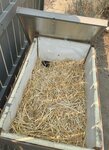


BREWSTER – Before sun-up every Monday through Thursday morning, a Brewster citizen/volunteer - who requests anonymity for this story - rolls out of a warm bed to begin a demanding routine that is gradually improving the quality of life for two groups of city inhabitants – its residents, and its feral cats.
This volunteer for Okanogan Regional Humane (ORH) - we’ll call him Catman - arrives at the Brewster river walk and with live traps that he has set in place by daylight.
“Then I wait for three hours before returning to check my traps to see if I caught any cats.,” said Catman. “If I caught cats, I take them to the vet.”
Since 2022 Catman has been carrying on a one-man campaign to trap, treat, neuter, and release the colonies of felines that have taken up residence in and around Brewster. The goal is to reduce the numbers of litters born to these free-roaming ferals – we are still speaking of cats, not citizens – while addressing the overall health of each captive before returning it to its home turf.
“It takes me from 5 a.m. to about noon every day to do this,” he said.
Catman was not an experienced trapper before he took up the gauntlet for his latest crusade. To his credit he did not let that deter him. Following a trapping tutorial Catman spent the summer of 2022 rounding up 41 cats from one Brewster-area colony. Now he feeds those he rescued and took to treatment.
That treatment begins with a trip to the Brewster Veterinary Clinic where ORH has an arrangement for services.
“They can do two cats a day without an appointment,” said Catman.
Each cat is vaccinated for rabies and three-way, treated for ear mites, flea and ticks, and is dewormed. Any serious injuries or other issues are also addressed.
“This is their only chance to see a vet; they’ll probably never see a vet again,” Catman said.
To save on treatment costs ORH can use its own vaccines, and expense is the core need for local shelters.
“Getting funding is the big problem,” said Catman. “It’s through donations. You’re begging for money every day of the week. There’s no funding…the city, the county, the state, nobody pays anything.”
Catman estimates the cost to treat the 41 cats in the colony he caught last year to be $6,000 or $7,000. This year he is trapping in five locations, three inside the city limits.
“I’ve trapped 29 cats so far this year in the city of Brewster.
Catman shared a few facts to illustrate the importance of trapping every cat in a colony to slow its growth rate.
“They can have a litter every 65 days and start reproducing when they are four months old,” Catman said, “Unfortunately in a feral colony you have brothers and sisters crossing, then the genetics are all screwed up.”
While these are feral animals some of young kittens can be tamed, socialized, and put up for adoption. Catman has socialized and found homes for nearly two dozen former feral cats himself. He would like to see some insulated shelters and cat-accessible feeders installed for the colonies.
“They are going to be there for at least 10 years whether or not you treat them humanely,” said Catman, and urges communities to embrace their reality. “There are so many cats out there that have such a horrible life.”
Catman has been volunteering with animal humane causes for decades and switched to a vegetarian diet about 20 years ago.
“Nothing has to die for me to have a plate of food anymore,” he said.
Comments
No comments on this item Please log in to comment by clicking here